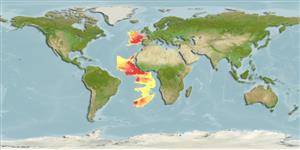Klassifizierung / Names
Namen | Synonyme | Catalog of Fishes(Gattung, Arten) | ITIS | CoL | WoRMS | Cloffa
>
Lophiiformes (Anglerfishes) >
Himantolophidae (Footballfishes)
Etymology: Himantolophus: Greek, himas or himantos = leather strap, thong or leash (referring to the thick leathery illicium) + Greek, lopho or lophio = crest or tuft (referring to the baited illicium projecting from the head) (Ref. 86949).
Environment: milieu / climate zone / depth range / distribution range
Ökologie
seewasser bathypelagisch; tiefenbereich ? - 2100 m (Ref. 46206). Deep-water
Eastern Central Atlantic: 1°04'N, 18°22'W (type locality).
Size / Gewicht / Alter
Maturity: Lm ? range ? - ? cm
Max length : 9.2 cm SL (female)
Kurzbeschreibung
Morphologie | Morphometrie
Rückenflossenweichstrahlen (insgesamt): 5; Afterflossenweichstrahlen: 4. Distinguishing characteristics of metamorphosed female: length of illicium 30-44% SL; each primary branch of distal escal appendage unbranched, single side branch emerging from posterior margin at varying distances from base; total length of escal appendage 18% SL in 3.2 cm specimens, 59-214% SL in 5.9-9.2 cm specimens; length of distal escal appendage 5% SL in 3.2 cm specimens, 15-34% SL in 5.9-9.2 cm specimens; side branches cylindrical or slightly tapering toward blunt tip; distal appendage covered with dermal spinules, except for tips (Ref. 86949).
Minimum depth from Ref. 58018.
Life cycle and mating behavior
Geschlechtsreife | Fortpflanzung | Ablaichen | Eier | Fecundity | Larven
Eschmeyer, W.N. (ed.), 2003. Catalog of fishes. Updated database version of March 2003. Catalog databases as made available to FishBase in March 2003. (Ref. 46206)
IUCN Rote Liste Status (Ref. 130435)
Bedrohung für Menschen
Harmless
Nutzung durch Menschen
Mehr Information
NamenSynonymeMetabolismusRäuberÖkotoxikologieFortpflanzungGeschlechtsreifeAblaichenSpawning aggregationFecundityEierEientwicklung
Alter/GrößeWachstumLänge-GewichtLänge-LängeLängenhäufigkeitenMorphometrieMorphologieLarvenLarven Pop.Dyn.RekrutierungDichteBRUVS
ReferenzenAquakulturAquakultur ProfilZuchtlinienGenetikElectrophoresesVererbbarkeitKrankheitenVerarbeitungNutrientsMass conversion
PartnerBilderStamps, Coins Misc.LauteCiguateraGeschwindigkeitSchwimmstilKiemenoberflächeOtolithsGehirngrößeSehfähigkeit
Tools
Zusatzinformationen
Download XML
Internet Quellen
Estimates based on models
Preferred temperature (Ref.
123201): 2 - 2.5, mean 2.3 °C (based on 800 cells).
Phylogenetic diversity index (Ref.
82804): PD
50 = 0.5000 [Uniqueness, from 0.5 = low to 2.0 = high].
Bayesian length-weight: a=0.01995 (0.00906 - 0.04395), b=3.01 (2.83 - 3.19), in cm total length, based on all LWR estimates for this body shape (Ref.
93245).
Trophic level (Ref.
69278): 4.5 ±0.37 se; based on food items.
Fishing Vulnerability (Ref.
59153): Low vulnerability (10 of 100).
